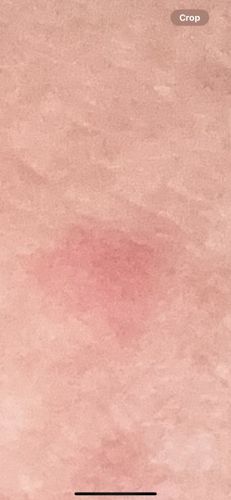Mosquito (presumed bite reaction)
Scientific Name: Various species within the Culicidae family (e.g., Anopheles, Aedes, Culex) (presumed bite reaction)
Order & Family: Order: Diptera, Family: Culicidae (presumed)
Size: Adult mosquitoes typically range from 3 mm to 10 mm in length. The image shows a bite mark, not the insect itself.

Natural Habitat
Mosquitoes are found worldwide in various habitats, especially near standing water bodies such as swamps, marshes, ponds, ditches, and artificial containers, as their larvae and pupae are aquatic. Adults can be found in vegetated areas, forests, and human dwellings.
Diet & Feeding
Female mosquitoes feed on blood (hematophagous) of humans and other animals for egg production. Male mosquitoes and, at times, females also feed on nectar and plant juices.
Behavior Patterns
The image provided shows a skin reaction, likely a bite, but does not show the insect itself. Therefore, specific behaviors of the insect cannot be determined from the image. However, if this is a mosquito bite, mosquitoes are most active during dawn and dusk. Only female mosquitoes bite, as they require a blood meal to produce eggs. They locate hosts using carbon dioxide, body heat, and odors. After biting, they typically fly away.
Risks & Benefits
Risks: Mosquitoes are significant vectors for numerous diseases worldwide, including Malaria, Dengue fever, Zika virus, West Nile virus, Chikungunya, and lymphatic filariasis. Bites cause itchy welts, and in some individuals, severe allergic reactions. Benefits: In their larval stage, mosquitoes are a food source for aquatic animals. Adult mosquitoes, particularly males, can act as pollinators for some plants when feeding on nectar.
Identified on: 9/4/2025